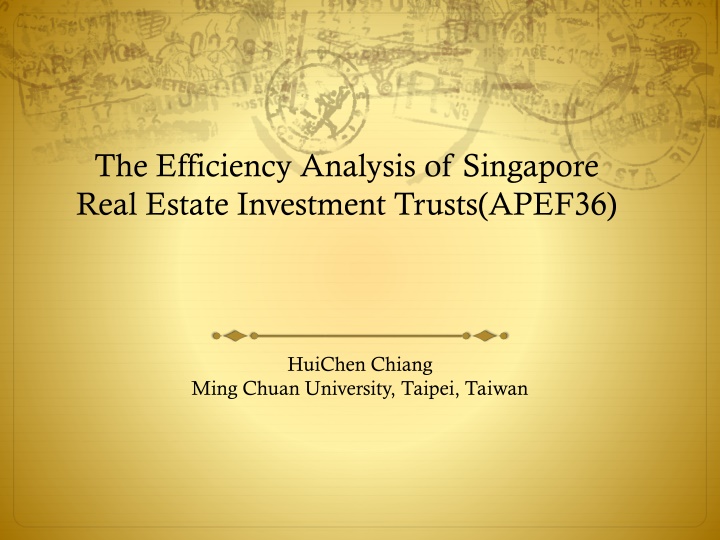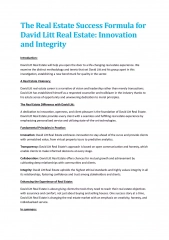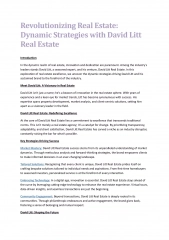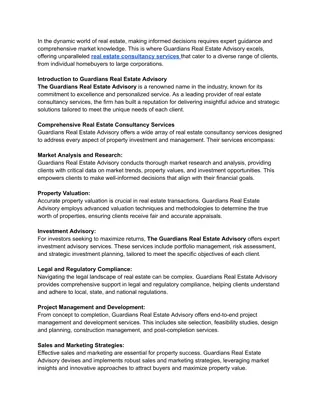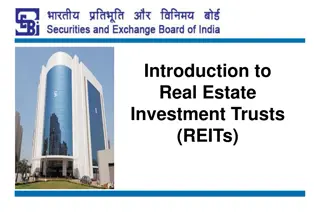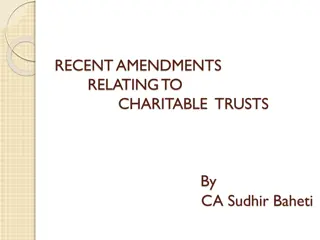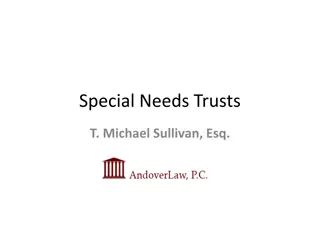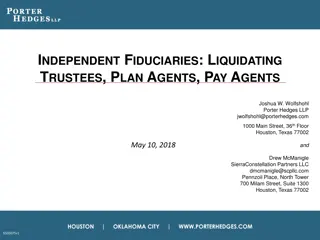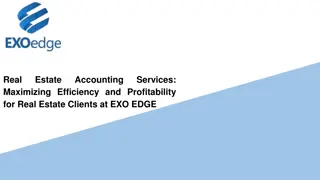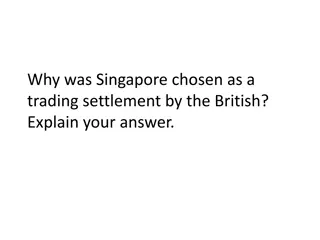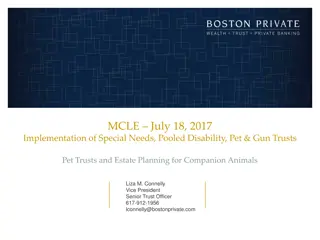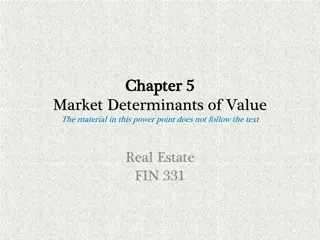Efficiency Analysis of Singapore Real Estate Investment Trusts
Analyzing the efficiency of Singapore Real Estate Investment Trusts (S-REITs) using Data Envelopment Analysis, exploring factors such as property type, geographical diversification, and size effect. The study aims to provide insights for improvement and policy shaping in the S-REIT market and address the lack of research in this area.
Download Presentation

Please find below an Image/Link to download the presentation.
The content on the website is provided AS IS for your information and personal use only. It may not be sold, licensed, or shared on other websites without obtaining consent from the author.If you encounter any issues during the download, it is possible that the publisher has removed the file from their server.
You are allowed to download the files provided on this website for personal or commercial use, subject to the condition that they are used lawfully. All files are the property of their respective owners.
The content on the website is provided AS IS for your information and personal use only. It may not be sold, licensed, or shared on other websites without obtaining consent from the author.
E N D
Presentation Transcript
The Efficiency Analysis of Singapore Real Estate Investment Trusts(APEF36) HuiChen Chiang Ming Chuan University, Taipei, Taiwan
Table of Contents Background Research Background and Objectives Literature Review Research Methods Findings Conclusion
One of the most influential city 3rdhighest annual GDP per capita High in HDI SINGAPORE Strong financial centre
Allowed to establish REITs in 1999 First successful launch in 2002 CapitaMall Trust Threats: China and India Second largest Asian REIT 28 REITs 6 stapled trusts Facing weak growth
Research Background & Objectives Motivation and Importance: Find efficiency level of REITs and suggest improvement Help shape government policies Remain competitive Strengthen S- REIT market position Lack of research on Singapore REITs
Research Background & Objectives 1stObjective: Find efficiency level of each S-REIT using Data Envelopment Analysis 2ndObjective: Property-type effect 3rdObjective: Geographical-diversification effect 4thObjective: Geographical focus effect 5thObjective: Size effect
Literature Review Data Envelopment Analysis Non-parametric mathematical modeling Use linear combination of inputs and outputs of the sample firms Deterministic attributes all deviations from optimal values as inefficiency Can handle multiple inputs and outputs No need to assign weights to each input and output Measures relative efficiency Stochastic Frontier Analysis Parametric regression technique Based on functional form Assumes stochastic relationship b/w inputs and outputs Two error terms: efficiencies, noise For standard SFA, only handle one input with multiple outputs Weights are assigned to inputs Measures optimal efficiency
Literature Review: Property-Type Property-type effect value-weighted premium, leverage ratio, G&A expenses, cash flow yield Capozza and Lee (1995) REITs of the same property type have similar returns and movements Mueller and Laposa (1996) Average return of office and industrial sector are consistently higher than their counterparts. Retail is also consistently lower. Chen and Peiser (1999)
Literature Review: Diversification Reduction in technical efficiency and increased in scale efficiency with increased in property-type diversification. In overall, no impact. Anderson, Fok, Springer, and Webb (2002) 64.4% of transactions that do not diversify experience positive returns returns while 61.2% that diversify experience negative returns Campbell, Petrova, and Sirmans (2003) Does not have an impact on performance Ro and Ziobrowski (2011), Topuz, Darrat, and Shelor (2005)
Literature Review: Size Larger REITs more efficient than smaller REITs for most years Anderson, Fok, Springer, and Webb (2002) Merger and acquisitions led to diseconomies of scale Topuz, Darrat, and Shelor (2005), Ambrose and Linneman (1998) Size effects value-weighted premium, leverage ratio, G&A expenses/Total Assets Capozza and Lee (1995) Size is positively correlated with efficiency Topuz and Isik (2009)
Research Method Quarterly report from REIT website Listed in SGX from Q12007 Q12015 14 REITs, 462 REITs observations Inputs: Property Operating Expense Management Fees Outputs: Total Revenue Total Assets DEA regressed against factors Tobit Regression Analysis
Research Method Geographical Diversification Geographical Focus Property-Type Size Herfindahl Index Retail Small Singapore Commercial Specialized Medium Overseas Others Diversified Large
Research Results Name Property-type Others (Industrial and Business Space) Others (Hospitality/Residential) Others (Industrial and Business Space) Commercial Retail Retail Others (Healthcare) Retail Market Focus Ascendas REIT Singapore Ascott Residence Trust Overseas (China) Cambridge Industrial Trust Capita Commercial Trust CapitaMall Trust CapitaRetail China Trust First REIT Fortune REIT Singapore Singapore Singapore Overseas (China) Overseas (Indonesia) Overseas (Hong Kong)
Research Results Name Property-type Market Focus Frasers Centrepoint Trust Retail Singapore Frasers Commercial Trust Commercial Singapore K-REIT Asia Commercial Singapore Mapletree Logistics Trust Starhill Global REIT Suntec REIT Others (Industrial and Business Space) Retail Commercial Singapore Singapore Singapore
Research Results 80,000 Property Operating Expense (Input) Manager s Fee (Input) 70,000 In thousands SGD 60,000 50,000 40,000 30,000 20,000 Total Revenue (Output) 10,000 0 2007 2008 2009 2010 2011 2012 2013 2014 2015 (Q1) Year Source: From this research
Research Results Total Assets (Output) 6,000,000 5,000,000 In thousands SGD 4,000,000 3,000,000 2,000,000 1,000,000 0 2007 2008 2009 2010 Year 2011 2012 2013 2014 2015 (Q1) Source: From this research
Research Results Standard Deviation Variable Average Maximum Minimum Property Operating Expenses Manager s Fees Total Revenue Total Assets 15,332 13,864 60,754 14 4,381 3,085 15,504 551 55,206 40,141 173,794 6,003 3,501,320 2,496,828 10,242,098 269,244 Expressed in thousand SGD
Research Results Mean 0.77188 0.86109 0.83712 0.90767 0.72215 0.7793 0.93527 0.71815 0.66294 0.59648 0.58591 0.67642 0.70945 0.53324 0.73551 Standard Deviation 0.134725 0.065586 0.186497 0.06106 0.024714 0.016578 0.04067 0.046599 0.019763 0.04047 0.067276 0.016912 0.053408 0.048237 0.138185 REIT s Name Ascendas REIT Ascott Residence Trust Cambridge Industrial Trust Capita Commercial Trust CapitaMall Trust CapitaRetail China Trust First REIT Fortune REIT Frasers Centrepoint Trust Frasers Commercial Trust K-REIT Asia Mapletree Logistics Trust Starhill Global REIT Suntec REIT Total
Research Results Operating Expense (as a % of Total Revenue) Manager s Fee (as a % of Total Revenue) Pearson Correlation Significant (two- tailed) *,**. Correlation is significant at the 0.05 and 0.01 level respectively -.077* -.404** 0.049 0 Operating Expense and Manager s Fee have (-) correlation with Efficiency!
Research Results Debt Ratio (Total Liabilities/Total Assets) ROA (based on Operating Profit) Pearson Correlation .371** -.155** Significant (two- tailed) **. Correlation is significant at the 0.01 level Source: From this research 0 0.001 ROA has (+) correlation with Efficiency! Debt Ratio has (-) correlation with Efficiency!
Research Results Standard Deviation Mean F Sig. Retail 0.7184 0.65583 0.81636 0.051122 0.157688 0.138633 Commercial Others 65.949 .000* **. Mean Difference between groups is significant at the 0.05 level (2-tailed) Source: From this research
Research Results Mean Differences (I J) (J) Sig. (I) Commercial Others Retail Others Retail Commercial .062574* .000 Retail -.097958* .000 -.062574* .000 Commercial -.160532* .000 .097958* .000 Others .160532* .000 **. Mean Difference is significant at the 0.05 level (2-tailed) Others > Retail > Commercial
Research Results Herfindahl Index 0.013 0.78 NO Pearson Correlation Significant (two-tailed) IMPACT! Standard Deviation 0.144256 0.123035 Mean t Sig. Specialized Diversified 0.73901 0.72737 0.83 0.407
Research Results Standard Deviation Mean t Sig. Overseas Singapore *. Mean Difference between groups is significant at the 0.05 level (2-tailed) 0.82345 0.094039 0.70033 0.137443 11.047 .000* Focus on Overseas!
Research Results Standard Deviation 0.137576 0.105521 0.150456 Mean F Sig. Small Medium Large 0.79119 0.69891 0.71642 21.062 .000* **. Mean Difference between groups is significant at the 0.05 level (2-tailed)
Research Results Mean Differences (J) (I J) Sig. (I) Medium .092286* 0 Small Large .074779* 0 Small -.092286* 0 Medium Large -0.017506 0.511 Small -.074779* 0 Large Medium 0.017506 0.511 **. Mean Difference is significant at the 0.05 level (2-tailed) Small > Medium = Large
Research Results Unstandardized Coefficient Estimated value of B 0.94 Collinearity Statistics t Sig. Variable Tolerance VIF Std. error Constant Property type Others Manager s fee (as a % of total revenue) Geographical Concentration Singapore 34.644 .000* 0.027 0.097 0.012 8.203 .000* 0.761 1.314 -0.742 0.099 -7.491 .000* 0.813 1.229 -0.079 0.012 -6.606 .000* 0.823 1.215 Debt Ratio Size Medium Operating Expense (as a % of total revenue) **. significant at the 0.05 level (2-tailed) -0.201 0.073 -2.749 .006* 0.791 1.264 -0.037 0.011 -3.467 .001* 0.981 1.02 -0.114 0.052 -2.202 .028* 0.699 1.43
Conclusion Property operating expense and management fee have (-) correlation with efficiency level Property-type: others do best followed by retail Most efficient: FIRST REIT Geographical diversification: does not matter ROA has a (+) correlation with efficiency level Least efficient: Suntec REIT Geographical focus: overseas Debt level has a (-) correlation with efficiency level Least consistent: Cambridge Industrial Trust Size: small-size REIT
